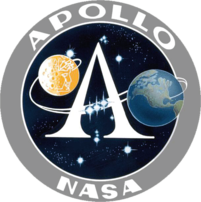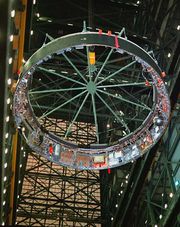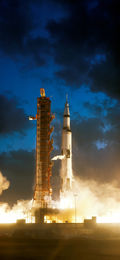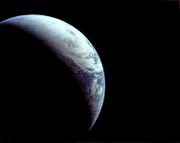Apollo 4
| Apollo 4 | |||||
|---|---|---|---|---|---|
Mission insignia |
|||||
| Mission statistics | |||||
| Mission name | Apollo 4 | ||||
| Command Module | CM-017 mass 23,401 kg |
||||
| Service Module | SM-017 | ||||
| Lunar Module | LTA-10R (dummy) mass 13,381 kg |
||||
| Spacecraft mass | 36,782 kg total | ||||
| Crew size | Unmanned | ||||
| Call sign | AS-501 | ||||
| Booster | Saturn V SA-501 | ||||
| Launch pad | Complex 39A Kennedy Space Center Florida, USA |
||||
| Launch date | November 9, 1967 12:00:01 UTC |
||||
| Landing | November 9, 1967 ~20:37:00 UTC 30° 06' N, 172° 32' W |
||||
| Mission duration | 8 h 36 m 59 s | ||||
| Number of orbits | 3 | ||||
| Apogee | 116.8 mi (188 km) | ||||
| Perigee | 113.7 mi (183 km) | ||||
| Orbital period | 88.3 m | ||||
| Orbital inclination | 32.6° | ||||
| Distance traveled | ~85,000 mi (~140,000 km) | ||||
| Related missions | |||||
|
|||||
Apollo 4, also known as Apollo-Saturn 501 (AS-501), was an A type mission - the first flight of the Saturn V launch vehicle, carrying no crew. It was also the first flight of the S-IC and S-II stages of the rocket. The launch, at 7:00 a.m. EST on November 9, 1967 from Launch Complex 39, was the first from the John F. Kennedy Space Center on Merritt Island. The mission tested the complete Saturn V and Apollo Command/Service Module (CSM) stack in what is known in the aerospace industry as an "all-up test", meaning all stages were live and functional. The mission tested the newly revised Block II Apollo Command Module and tested its heat shield at simulated lunar-return speeds of approximately 25,000 mph (40,000 km/h). The mission was deemed by NASA as a complete success. It helped advance the Apollo program in its goal of landing men on the Moon by the end of the 1960s.
Contents |
Objectives

This was the first flight of the Saturn V, the largest launch vehicle ever to fly successfully. It was also the first launch from Launch Complex 39, which was specifically built for the Saturn V. As well as being the first launch of the S-IC first stage and S-II second stage, it would also be the first time that the S-IVB third stage had been restarted in Earth orbit and the first time that the Apollo spacecraft had reentered the Earth's atmosphere at speeds approaching those of a lunar return trajectory. Because of all these firsts there were 4,098 measuring instruments on board the rocket and spacecraft.
This would be the first test of the all-up doctrine. It had been decided in 1963 that instead of testing each component of the rocket separately as had been done by Wernher von Braun in Germany during World War II, the rocket would be tested all at once. This cut down the total number of tests, as needed to accomplish President Kennedy's stated goal of a manned lunar landing by 1970, but it meant that everything had to work properly the first time. Apollo program managers had misgivings about all-up testing but agreed to it with some reluctance since individual component tests would inevitably push the landing mission past the 1970 goal.[1][2]
There were two main payloads on board. CSM-017 was a production model of the spacecraft. It was a Block I design meant for systems testing, and not the Block II spacecraft that had the mechanisms for docking with the Lunar Module, which is necessary for landing on the Moon. However it did feature some Block II upgrades such as an improved heat shield and a new hatch. The other payload was LTA-10R which was a model of the Lunar Module carried as ballast but with the same mass distribution as the real craft.
The pieces arrive

The first piece of the Apollo 4 to arrive at the Kennedy Space Center was the third stage. This was built by Douglas Aircraft Company and was small enough to be transported by plane, though it was no ordinary plane, being an Aero Spacelines, Inc. Pregnant Guppy. The other stages were much larger and had to travel by barge, with the first stage arriving next from Boeing Company at Michoud, Louisiana along the Banana River. The second stage was late in arriving but the rocket was still erected in the Vehicle Assembly Building, using a huge barbell shaped spool in the place of the second stage.
The CSM arrived on December 24, 1966, followed by the second stage on January 12, 1967. Only two weeks later the fatal fire in the Apollo 1 spacecraft occurred, pushing all the schedules back. An inspection of wiring in the CSM found 1,407 problems.
The stacking of the S-II took place on February 23. This was a precision process; supposedly the crane operators could conceivably "lower the crane hook on top of an egg without breaking the shell". The piece had to be unstacked after hairline cracks were found in another S-II. The CSM was finally ready as well and on June 20 it was mated to the rocket and the whole launch vehicle rolled out of the VAB on August 26 - six months after the originally scheduled launch date.
Flight

After a testing regime that lasted two months the rocket was finally ready for launch. The propellant started being loaded on 6 November. In total there were 89 trailer-truck loads of LOX (liquid oxygen), 28 trailer loads of LH2 (liquid hydrogen), and 27 rail cars of RP-1 (refined kerosene).
The five F-1 engines sent a huge amount of noise across Kennedy Space Center. To protect from a possible explosion, the launch pads at LC-39 were at least three miles from the Vehicle Assembly Building. However, the noise was much stronger than expected and buffeted the VAB, Launch Control Center and press buildings. Ceiling tiles fell around Walter Cronkite in the CBS News booth. NASA later built a sound suppression system that pumped thousands of gallons of water onto the flame trench under the pad. A similar system was used with Space Shuttle launches.
The perfect launch placed the S-IVB and CSM into a 185 kilometer orbit. After two orbits, the S-IVB reignited for the first time, putting the spacecraft into an elliptical orbit with an apogee of more than 17,000 kilometers. The CSM separated from the S-IVB and fired its Service Propulsion System (SPS) engine to send it out to 18,000 kilometers. Passing apogee, the Service Propulsion System fired again to increase re-entry speed to 40,000 km/h, simulating a return from the Moon.
The CM landed 16 km from the target landing site. Its descent was visible from the deck of USS Bennington, the prime recovery ship.
Cameras
Documentaries often use footage of a Saturn V launch, and one of the most used pieces shows the interstage between the first and second stages falling away. This footage is usually mistakenly attributed to the Apollo 11 mission, when it was actually filmed on the flights of Apollo 4 and Apollo 6. Footage from Apollo 4 is seen in the Star Trek episode "Assignment: Earth".
A compilation of original NASA footage shows the jettisoning of the first stage (S-IC) and the interstage, filmed from the bottom of the second stage (S-II), both from Apollo 4. This is followed by footage of the separation of an S-IVB second stage from the first stage of a Saturn IB. The glow seen on the jettisoned stages is due to the hot, invisible hydrogen-oxygen flames of the J-2 engines used by the S-II and S-IVB. The footage also shows the more conspicuous plumes of the solid ullage motors as they pull the stages apart before the main engines are fired.
The cameras ran at 15 times normal speed to show the events in slow motion. The camera capsules were jettisoned soon after the first stage separation and though at about 200,000 feet in altitude, were well below orbital velocity. They then reentered the atmosphere and parachuted to the ocean where they floated waiting for recovery. Both S-II cameras from Apollo 4 were recovered so that there is footage from both sides of the vehicle.[3]
Earth images

The Command Module contained an automatic camera which captured the first US photographs of the entire Earth. A total of 755 70mm color images were taken through the pilot's window, at altitudes ranging from 13,800 to 18,240 kilometers. [4]
An image of the crescent Earth from Apollo 4 appeared on the front cover of The Last Whole Earth Catalog, with the following credit:
This is probably the first American photograph of the "whole Earth." You're looking west over the Atlantic Ocean, with the Antarctic continent just visible at the bottom of the crescent. The picture was released in 1967, but no one seemed to care about noticing it or publishing it. I think it was the shadow, which frightened people. There are no shadows on our maps.[5]
Capsule location
The Command Module is on display at the NASA's John C. Stennis Space Center, Bay St. Louis, Mississippi.
References
- ↑ Dr. Space (biography of von Braun), by Bob Ward
- ↑ First Man (biography of Neil Armstrong) by James R. Hansen
- ↑ Saturn V Launch Vehicle Flight Evaluation Report--AS-501 Apollo 4 Mission
- ↑ Analysis of Apollo AS-501 Mission Earth Photography
- ↑ Brand, Stewart, ed., The Last Whole Earth Catalog, Palo Alto, CA: Portola Institute, 1971
External links
- Apollo 4 flight listing NASA NSSDC catalog
- Moonport: A History of Apollo Launch Facilities and Operations
- Chariots for Apollo: A History of Manned Lunar Spacecraft
- John C. Stennis Space Center
|
||||||||||||||||||||||||||